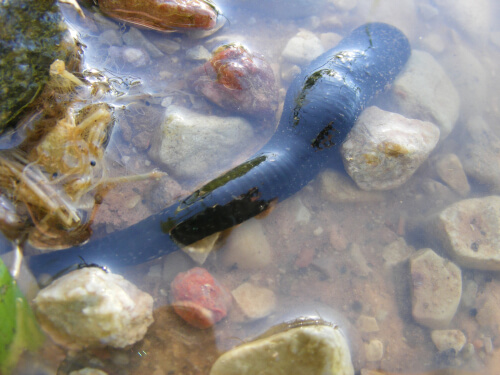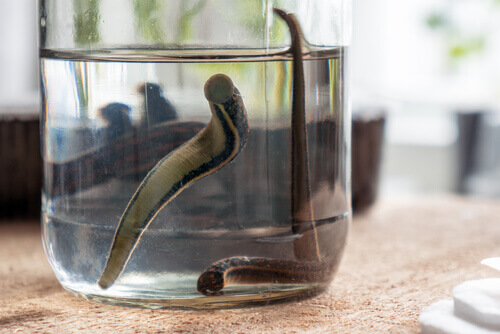Leeches: Characteristics and Reproduction

Leeches are worm-like invertebrate animals that belong to the group of annelids. They’re related to earthworms, but differ from them by the presence of suckers on their bodies and because most of them live in water.
Although most people hate them, leeches have proved to be very useful in medicine, especially in microsurgery and in the case of some transplants. They have been shown to be effective in many clinical approaches, although today there are somewhat more “humane” options for treating diseases.
There are about 600 species of leeches worldwide. The best known is the medicinal leech or common leech, whose scientific name is Hirudo medicinalis. Here are some facts to better understand the characteristics and reproduction of leeches.
What are leeches?
As mentioned above, all leeches belong to the phylum Annelida, which is shared with earthworms and other worms (freshwater, terrestrial or marine). However, they split from their distant relatives to form their own subclass: Hirudinea. To date, 680 species of leeches have been recorded, of which 100 are marine, 480 freshwater, and 100 terrestrial.
Although they form part of a rather small taxon, it should be noted that leeches have colonized practically the entire world (with the exception of Antarctica). However, the preferred habitat of almost all leeches is shallow lakes full of vegetation and with no currents.
Physical characteristics
A leech generally measures between 5 and 12 centimeters (2 to 5 inches). However, the world’s largest species (Haementeria ghilianii), which lives in the Amazon rainforest, can measure up to 30 centimeters (12 inches). The leech’s body has the ability to dilate greatly in order to store all the blood it sucks.
The color of this animal varies according to the species. Most individuals are dark in color, although some have the ability to change color in response to different stimuli. They have a fixed number of body segments and each segment has several subdivisions.
The leech has two suction cups, a small one at the front and a larger one at the back. In order to move, they hold their anterior sucker and then drag the other segments of their bodies. To swim, they perform rapid undulations thanks to their muscles.
Specifically, Hirudo medicinalis can reach up to 20 centimeters (8 inches) in length in its adult stage and has a black-greenish color. Its body is dorsoventrally flattened and divided into 33-34 segments.

Habitat
With the exception of Antarctica, leeches live on all continents. However, most are found in tropical areas. This is because they’re better adapted to warm climates and aquatic environments. As they’re ectothermic animals (their body temperature depends on the ambient temperature), very cold climates aren’t very suitable for their development.
The species we’re concerned with here (Hirudo medicinalis) is distributed throughout most of Europe, although it has also colonized a large part of Asia. Its preferred habitat is very shallow puddles or lakes with mud substrate and a large amount of vegetation. It’s an amphibious invertebrate, which means that to carry out its life cycle it must spend time both in water and on land.
The leech population worldwide has declined alarmingly. In fact, in some countries, measures have been taken to preserve them. The reason for this decline is the indiscriminate use of specimens for aesthetic and medicinal purposes. Hirudo medicinalis is listed as”Near Threatened” by the IUCN.
Some leeches live in freshwater and feed on substances present in mollusks and worms, while other species are carnivorous. There are also the ‘blood-sucking’ leeches, which attach themselves to the bodies of vertebrates to suck their vital fluid and feed on it.
The species in question here is parasitic and attaches itself in its adult stage to the surface of mammals to suck their blood. Curiously, with its bite, the creature injects a series of anesthetics that prevent the host from noticing its presence. Thus, it takes the opportunity to ingest about 10-15 milliliters of blood fluid in about 20-40 minutes and increase its size by 8 to 11 times.
An adult leech feeds every 6 months, as it takes a long time to digest such a large amount of blood.
Leech behavior
Although leeches appear to be primitive beings with a basal body, it should be noted that they have more capabilities than just adhering to the surface of their host. Some of the most interesting are the following:
- They adopt a resting posture: When they’re digesting blood, leeches flatten their body and take shelter under stones at the waterline, partially out of the water.
- They’re able to recognize shadows: Leeches can recognize this light stimulus in an advanced way. In this way, they prepare to attach themselves to the mammal when they perceive its shadow on land or in water.
- All for food: These invertebrates are sensitive to light stimuli, heat, and desiccation. However, they don’t take much notice when they’re attached to their host and sucking blood.
Leech reproduction
Leeches are mostly hermaphrodites. Each individual has several pairs of testes and one pair of ovaries. Reproduction is by internal fertilization (a copulatory organ enters the vagina and sperm are released), however, the process varies from species to species. In Hirudo medicinalis copulation is on land and once a year (June-August).
Other aquatic species such as those of the genus Erpobdella lay their eggs in water. These are maintained by a protective barrier.
In some species, the sperm are stored in spermatophores that live separately from the couple and fertilize the ovaries through the wall. When mating occurs, fertilization is often reciprocal. Once fertilized, the eggs are deposited in a series of cocoons of chitinous consistency. The offspring are the same color and shape as the adults.

Human health benefits
The leech has been used since ancient Roman times to relieve pain and treat diseases of all kinds, from obesity to eye disorders and mental pathologies.
The animal’s suction of blood is beneficial in alleviating these ailments. The efficacy of these treatments has been confirmed by a large number of investigations carried out around the world.
Treatments using leeches to suck blood are completely painless. This occurs because this animal secretes analgesic and antibiotic substances in order to anesthetize its hosts, as mentioned above. The leech’s saliva is responsible for transmitting these substances.
The leech is widely used in anticoagulant treatments. Another substance present in the body of this animal dissolves clots and prevents them from reproducing. This considerably reduces the risk of thrombosis.
More than 60 compounds have been isolated in leech saliva, some of which have analgesic, anesthetic, anticoagulant and vasodilatory properties.
All cited sources were thoroughly reviewed by our team to ensure their quality, reliability, currency, and validity. The bibliography of this article was considered reliable and of academic or scientific accuracy.
- Coggeshall, R. E., & Fawcett, D. W. (1964). The fine structure of the central nervous system of the leech, Hirudo medicinalis. Journal of neurophysiology, 27(2), 229-289.
- Hildebrandt, J. P., & Lemke, S. (2011). Small bite, large impact–saliva and salivary molecules in the medicinal leech, Hirudo medicinalis. Naturwissenschaften, 98(12), 995-1008.
- Harvey, R. P., Degryse, E., Stefani, L., Schamber, F., Cazenave, J. P., Courtney, M., … & Lecocq, J. P. (1986). Cloning and expression of a cDNA coding for the anticoagulant hirudin from the bloodsucking leech, Hirudo medicinalis. Proceedings of the National Academy of Sciences, 83(4), 1084-1088.
- Gray, J., Lissmann, H. W., & Pumphrey, R. J. (1938). The mechanism of locomotion in the leech (Hirudo medicinalis Ray). Journal of Experimental Biology, 15(3), 408-430.
This text is provided for informational purposes only and does not replace consultation with a professional. If in doubt, consult your specialist.